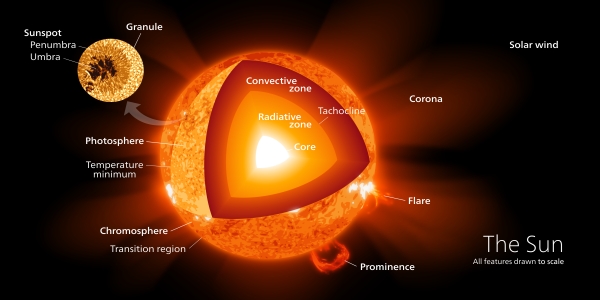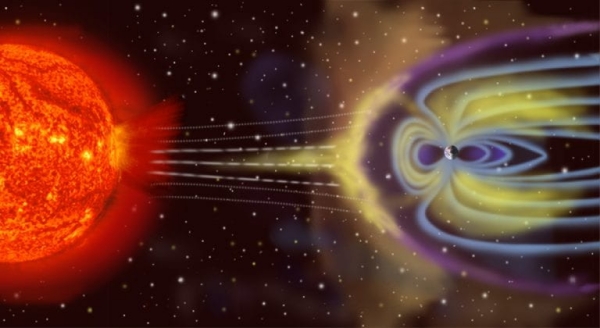Looking at flare activity in young M-dwarf stars, as we did in the last post, brings out a notable difference between these fast-spinning stars and stars like the Sun. Across stellar classifications from M- to F-, G- and K-class stars, there is commonality in the fusion of hydrogen into helium in the stellar cores. But the Sun has a zone at which energy carried toward the surface as radiative photons is absorbed or scattered by dense matter.
At this point, convection begins as colder matter moves downward and hot matter rises. This radiative zone giving way to convection is distinctive — stars in the M-class range, a third of the mass of the Sun and lower, do not possess a radiative core, but undergo convection throughout their interior.

Image: Interior structure of the Sun. Credit: kelvinsong / Wikimedia Commons CC BY-SA 3.0.
If we’re going to account for magnetic phenomena like starspots, flares and coronal mass ejections, we can come up with a model that fits stars with a radiative core, but fully convective stars might be expected to have a different kind of magnetic dynamo. What stands out in the data, however, is that the relationship between the star’s rotation and its magnetic activity appears the same for stars on both sides of what I might call the ‘convective divide.’ In both cases, the magnetic dynamo seems to be efficient despite the fact that M-dwarfs are fully convective.
Digging further into the subject is a new paper out of Rice University, where modeling of these phenomena examines the linkage between the rotation of stars and the behavior of their surface magnetic flux. The flux in turn governs the luminosity of the star at X-ray wavelengths, giving us a way to probe magnetic activity and its potential effects on planets in these systems. The paper explaining the new model has just run in The Astrophysical Journal. Lead author Alison Farrish comments on the implications over time as rotation periods change:
“All stars spin down over their lifetimes as they shed angular momentum, and they get less active as a result. We think the sun in the past was more active and that might have affected the early atmospheric chemistry of Earth. So thinking about how the higher energy emissions from stars change over long timescales is pretty important to exoplanet studies.”

Image: Rice University scientists have shown that “cool” stars like the sun share dynamic surface behaviors that influence their energetic and magnetic environments. Stellar magnetic activity is key to whether a given star can host planets that support life. Credit: NASA.
Farrish and team used the Rossby number of our own star to model the behavior of other stars. This value measures stellar activity through the combination of rotational speed and subsurface liquid flows that influence how the magnetic flux is distributed on the stellar surface. Presumably the magnetic field in stars with a radiative zone is generated at the interface between the interior radiative region and the outer convective zone. The Rossby number relates the rotation of the star — determined through observation — to the internal convective activity of the star.
The results affirm that the mechanisms producing local ‘space weather’ are common across different stellar classes, meaning we can with some confidence examine planetary systems around M, F, G and K stars using the same model. The process generating a star’s magnetic field may thus turn out to be similar despite the presence, or lack, of a radiative core. Adds co-author Christopher Johns-Krull:
“A lot of ideas about how stars generate a magnetic field rely on there being a boundary between the radiative and the convection zones, so you would expect stars that don’t have that boundary to behave differently. This paper shows that in many ways, they behave just like the sun, once you adjust for their own peculiarities.”
Thus an M-dwarf with a Rossby number typical for its class shows magnetic behaviors close enough to the Sun for us to make predictions about their effect on its planets. The stellar magnetic field data are, in turn, affected by the activity cycle of individual stars, which the model does not include because this would demand lengthy observational study for each star. But from the perspective of magnetically active stars, the new model from Farrish and team can be applied to interactions within their systems.
We’re a long way from knowing whether M-dwarf systems like that at Proxima Centauri or the intriguing TRAPPIST-1 and L 98-59 could support living planets, but our models for their magnetic interactions can draw on what we see in our own Sun, despite its differences in age and stellar class. Refining that model for these systems will help us determine the most likely M-dwarf candidates for habitability.
The paper is Farrish et al., “Modeling Stellar Activity-rotation Relations in Unsaturated Cool Stars,” Astrophysical Journal Vol. 916, No. 2 (3 August 2021). Abstract.



This has a much deeper connection to the 11 year solar cycle and the flipping of the magnetic poles with the butterfly of the sunspot cycle. We have only seen the flipping taking place in one other star in all the observations obtained and that was a 2 year cycle in a F7IV-V called Tau Boötis. Some 50 lightyears away with a fast rotation of 3.31 days it has the distinction of the only star with radio emissions from a planet beyond our solar system. Seems we have hit a wall “Similar Magnetic Activity Links Stellar Types” would not be what I would call these two stars by any means.
https://en.wikipedia.org/wiki/Tau_Bo%C3%B6tis#cite_note-Donati2008-13
Apparently this technique, known as Doppler imaging (DI) and Magnetic/Zeeman Doppler imaging (MDI/ZDI), represents the highest resolution indirect imaging method currently used in astronomy and is being used to map M dwarfs magnetic fields. The picture changes drastically when looking at the fully convective of M5 and later.
Magnetic fields of M dwarfs.
https://link.springer.com/article/10.1007/s00159-020-00130-3
Next we come to the star TVLM 513-46546 a M9 Red dwarf with a 2 hour rotation period.
Tiny Red Dwarf Star Has a Magnetic Field Several Hundred Times Stronger Than Our Sun.
https://scitechdaily.com/tiny-red-dwarf-star-has-a-magnetic-field-several-hundred-times-stronger-than-our-sun/
But what is interesting about this star???
Multi-frequency long-term monitoring of the ultracool dwarf TVLM 513-46546.
“Recently, observations of three ultracool dwarfs have shown that the emission is in fact due to the electron cyclotron maser instability operating in the low plasma density, high magnetic field strength regions above the poles of a large-scale magnetic field, i.e. it is similar to that of the magnetized planets in the Solar system. The M8.5 dwarf TVLM 513-46546 is one of the most studied radio emitting dwarfs. It has been found to display periodic pulses of 100% circularly polarized radio emission, the periodicity of the bursts being consistent with the rotational period of the dwarf as confirmed by optical I band observations . Here we present a systematic review and analysis of all observations of TVLM 513-46546 conducted in the radio X and C bands, including our latest VLA and Arecibo observations.”
So they think the sun is a good example to create models from when it is only one of two stars that flips it magnetic field…Hmmm.
Maybe we should use the BILLIONS of M dwarfs out there to model what are the 80% percent of all stars in our galaxy instead of our flippant sun. Or maybe Jupiter… ;-}
Maybe this was already covered, but I had missed it in my mailbox about a year and a half ago. There was a report in Science, 1st of May 2020, pp.
518-519.
STELLAR PHYSICS
“The Sun is less active than other solar-like stars”
Timo Reinhold1*, Alexander I. Shapiro1, Sami K. Solanki1,2, Benjamin T. Montet3, Natalie A. Krivova1,
Robert H. Cameron1, Eliana M. Amazo-Gómez1,4
ABSTRACT:
The magnetic activity of the Sun and other stars causes their brightness to vary. We investigated how typical the Sun’s variability is compared with other solar-like stars, i.e., those with near-solar effective temperatures and rotation periods. By combining 4 years of photometric observations from the Kepler space telescope with astrometric data from the Gaia spacecraft, we were able to measure
photometric variabilities of 369 solar-like stars. Most of those with well-determined rotation periods showed higher variability than the Sun and are therefore considerably more active. These stars appear nearly identical to the Sun except for their higher variability. Therefore, we speculate that the Sun could potentially also go through epochs of such high variability.
=====
The results plotted out on HR diagrams, including overlays for the similarly aged ( 4.5 billion years) shows that the sun is an outlier in the sense of its quiescence – currently. It is not clear that this has been a temporary situation or a feature of the sun’s behavior all its life. But if 330 observed G stars say “aye” to the notion of “let’s rumble” and Sol appears to be one of the few naysayers, then that at least suggests that
G stars spend the majority of their time in a manner more active than the present day sun, suggesting that the sun is more anomalous than the abstract concludes. And yet from other studies I infer we have not yet discovered why there should be such a distinction.
Going off on conjecture or hypothesis, I note that the solar cycle and Jupiter’s orbital period are fairly resonant. Then given that, could there be some connection between planets and E-M behavior? Well, radial velocity and Kepler surveys have detected all manner of planets, massive and terrestrial. There could be some interface, but I fail to see how that would point to the sun being unique among G MS stars.
However, if we are living in an unusual episode, then the E-M differences between G stars and M dwarfs with respect to habitability are diminished overall. But, if not, then we once again become more exceptional in our circumstances.